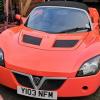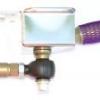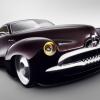Gary, I notice you are overly picky with everything (but your own stuff).
My solution works fine, never leaks, is durable, can accommodate power hikes and is safe. Hence why I suggested it. Yes it makes noise, if that a worry for the OP then he's welcome to exclude it as an option, however in an already incredibly noisy open top car it's not a real world problem.
There are countless thousands of cars with 044 pumps in them as after-market solutions, with good reason.
Before I start on the points Nev I would like to point out that at no time on this thread have a promoted my own products or even mentioned them apart from the price difference between the OE units when they were available and more expensive. All the comments were of a factual nature regarding the OE unit spec/availability and your setup/mods.
But that may change .... 
Sometimes, yes but that is for a reason Nev, most people who read these forums are not as informed as some and come here to get reliable information, so it is only fair to give all the advantages and disadvantages of the different options so these can be considered, no? Of course, my suggestion was one of several options, I wasn't saying an OEM type pump is bad, simply that an 044 pump is another solution.
It is an option for YOUR application Nev but not for the OP who doesn't have a 550bhp car so such a pump and swirl pot setup would be wholly inappropriate and would probably cause issues as mentioned before, also he doesn't have a lift pump so for the cheap, low power option he requested info for, this is looking pretty expensive: - 2 pumps, swirl pot, bunch of fittings, extra filter, extra wiring harness, etc.
It has only just been explained on your last post that these are noisy, you may consider the installation safe but I would disagree, having a HP fuel supply fitted into the passenger cabin which may easily be ruptured during a major shunt would not be my choice and I suspect the insurance would take a really dim view of it as well. If you are happy with it that's fine as you take all the risk of course, but endorsing it on a forum without a full explanation would not be fair. The cabin/seats/fuel tank zone is structurally the safest place from penetration, its in the centre of the car, deliberately protected from penetration by design. Placing a fuel pump on/near the bulkhead area (near the existing fuel filter) is probably as safe a pace as you could find on the car - its where mine is. If the parts are tied down no sort of "major shunt" should dislodge them. The risk is always from penetration IMO, and as I've mentioned, its the safest location/zone in the car.
Because pipes never split? and fuel fitting seals do not pop? the thought of having high pressure atomised fuel spraying an explosive mix inside the cockpit over the occupants is beyond reasonable Nev.
In an impact nothing is protected from the G, I'm sure you have seen slo mo of what goes flying around the inside of the car during a crash, a small heavy item like a pump is unlikely to remain fixed in position and the bulkhead panel* would not take it anyway.
​*Commonly referred to in the aviation industry as a firewall!
​I'm sorry Nev but we will have to differ, I cannot consider such a setup safe, if it were all in the engine bay it would be a different story.
The reason I am not so picky with what we supply is that we have spent a lot of time and effort getting things as good as they can be, the risk is never higher that the OE setup is and usually lower as with the toe links for example. Im sure you do, and thats commendable. However there are other options in life, one of which is my suggestion.
The first question that I ask to anyone asking for a pump conversion is what is the power requirement and future plans, pumps are then selected based on requirement + margin, this keeps fuel recirculation and pump power draw and noise to a minimum, so basically all of the problems I have highlighted before in this thread have been considered before a product is assembled and sold. So effectively the issues mentioned do not exist with out products.
The comments about the 044 was for an OE VX not the other countless thousands of applications. Precisely, just buying off the shelf VX stuff is NOT the only option. Which is why I mentioned it.
Partly true Nev but it does depend upon a number of factors, if the OP wants OE power and cheap, then options are limited to those requirements, a £600+ VHP installation is not really a solution for him as it fits none of his requirements.
Ta

What was wrong with your first installation? It wasn't powerful enough to deliver for 550 HP. I installed a new pump simply as a lifter pump to supply the swirl pot, the 044 is then next in sequence delivering to the fuel rail. That series of pressure would be enough for 600+ HP, so I have minimal risk of fuel starvation hopefully.
​OK, well now taking the opportunity to promote our own stuff 
The best place for a swirl pot is actually inside the tank (a trapped section) as this cuts down on exposed fuel lines and avoids secondary everything, refill of the trapped section (swirl pot) is very quick and doesn't cost you another pump.
We could have supplied you with an in tank pump unit conversion with the capability of up to 800bhp including margin, this unit would have a working refill for the canister in addition to the trapped section which would allow you to go down to the last few drops of fuel in the tank.
The pump only draws 13.5 amps and supplies 300lph at 70psi so you could have used the OE wiring harness.
You could also use the OE fuel lines and filter.
It would have been much more efficient, much neater, much safer and much quieter, at around £270 + vat I would guess it is considerably cheaper than your installation also??
Even so, I would not recommend this option for the OP though we could fit a much lower output pump to suit his needs, this would be cheaper and very reliable in the long term.
Why did you have to replace it with the 044? Dual pumps, dual fuel filters - a SOP for powerful cars. I chose a sequential setup instead of parallel simply due to size/placement constraints and ease of installation.
OK, well SOP for modified cars, as the single pump solution is usually hard to achieve and the tank shape usually unsuitable for use at low levels, most cars which have the power as standard use an in tank pump or dual pumps one on each side of the tank to reduce starvation. Obviously the new engines with direct injection have a mechanical VHP pump on the engine.
Thanks for the info Nev

![]()

















